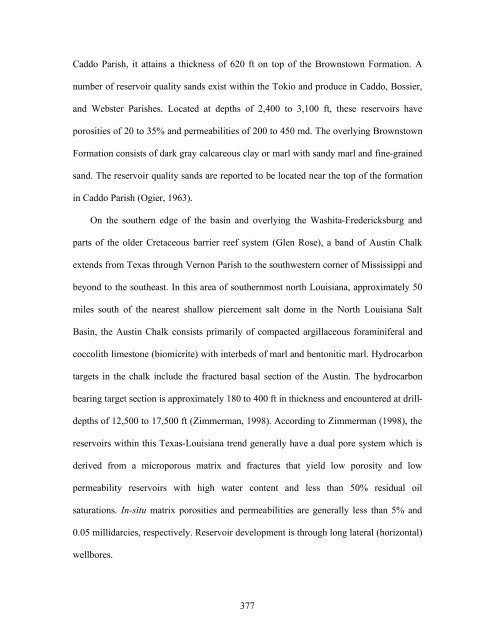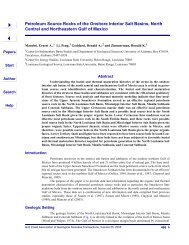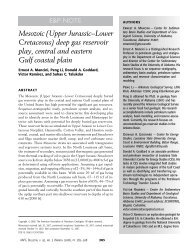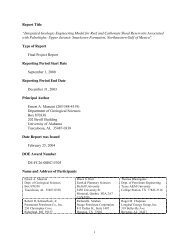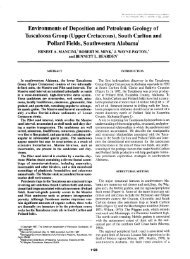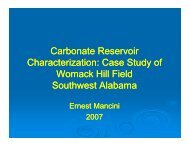Part 4 - Berg - Hughes Center
Part 4 - Berg - Hughes Center
Part 4 - Berg - Hughes Center
Create successful ePaper yourself
Turn your PDF publications into a flip-book with our unique Google optimized e-Paper software.
Caddo Parish, it attains a thickness of 620 ft on top of the Brownstown Formation. A<br />
number of reservoir quality sands exist within the Tokio and produce in Caddo, Bossier,<br />
and Webster Parishes. Located at depths of 2,400 to 3,100 ft, these reservoirs have<br />
porosities of 20 to 35% and permeabilities of 200 to 450 md. The overlying Brownstown<br />
Formation consists of dark gray calcareous clay or marl with sandy marl and fine-grained<br />
sand. The reservoir quality sands are reported to be located near the top of the formation<br />
in Caddo Parish (Ogier, 1963).<br />
On the southern edge of the basin and overlying the Washita-Fredericksburg and<br />
parts of the older Cretaceous barrier reef system (Glen Rose), a band of Austin Chalk<br />
extends from Texas through Vernon Parish to the southwestern corner of Mississippi and<br />
beyond to the southeast. In this area of southernmost north Louisiana, approximately 50<br />
miles south of the nearest shallow piercement salt dome in the North Louisiana Salt<br />
Basin, the Austin Chalk consists primarily of compacted argillaceous foraminiferal and<br />
coccolith limestone (biomicrite) with interbeds of marl and bentonitic marl. Hydrocarbon<br />
targets in the chalk include the fractured basal section of the Austin. The hydrocarbon<br />
bearing target section is approximately 180 to 400 ft in thickness and encountered at drill-<br />
depths of 12,500 to 17,500 ft (Zimmerman, 1998). According to Zimmerman (1998), the<br />
reservoirs within this Texas-Louisiana trend generally have a dual pore system which is<br />
derived from a microporous matrix and fractures that yield low porosity and low<br />
permeability reservoirs with high water content and less than 50% residual oil<br />
saturations. In-situ matrix porosities and permeabilities are generally less than 5% and<br />
0.05 millidarcies, respectively. Reservoir development is through long lateral (horizontal)<br />
wellbores.<br />
377


